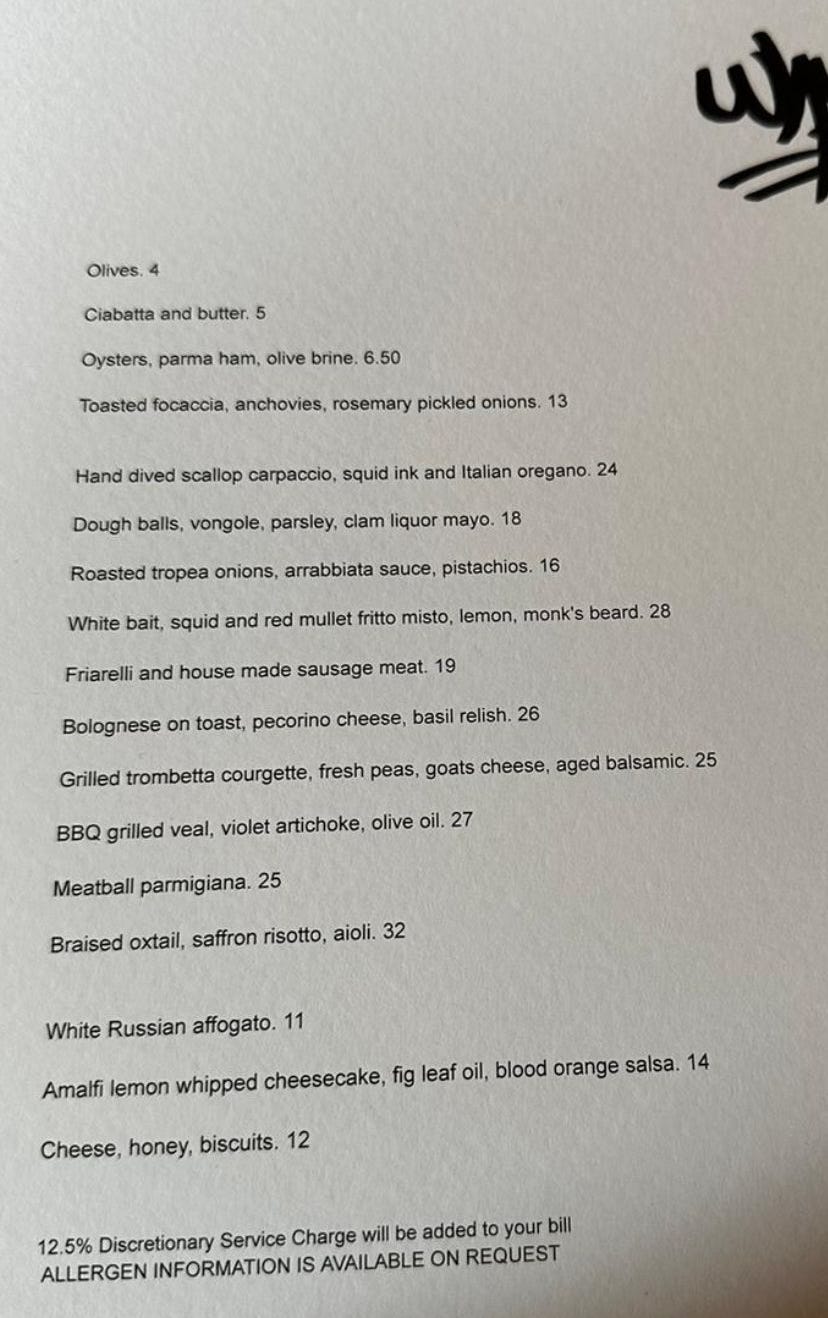A Certain Tendency of British Restaurants
The Gastronomic Neverland of London Fields. A review of Papi, Sune and Whyte's by Jonathan Nunn
Good morning and welcome back to Vittles Restaurants.
Vittles Reviews is a column dedicated to critical reviews of London restaurants, written by Jonathan Nunn. You can read all the previous reviews here.
A Certain Tendency of British Restaurants
A review of Papi, Sune and Whyte’s, by Jonathan Nunn
About two years ago, some friends and I attempted to identify a certain tendency in British cooking that we had kept noticing, but didn’t yet have a name for. This new style was eclectic in its references, taking in Americana, French grande cuisine, Japanese ferments and nostalgia for British industrial foods. The menus blended high and low without distinction, plating produce from some of the best farms in the UK with condiments you could find on a supermarket shelf. For reasons nominally related to sustainability, whey was often involved. The naming of dishes – oysters with green glitter sabayon, rabbit glazed in fig leaf and Szechuan daikon – was irreverent, polyglottal and held a healthy disrespect for national boundaries (although there would often be a menu item simply entitled ‘cheeseburger’.) The chefs behind this food were almost universally male, in their late twenties and either Australian or Australian-adjacent. Although they talked about their teenage love of Morley’s, you suspect they would not give you a straight answer if you asked where they went to school. And above all else, it was close to certain that the restaurant existed within a mile radius of London Fields in Hackney.
We never came up with an adequate name (Modern global? Condiment cuisine? Haute leftovers?) but since then, its signifiers have become unignorable. This year alone I’ve spotted the following in London Fields: smoked whey, whey butter, brown butter waffle, brown butter hollandaise, perry mignonette, BBQ strawberry mignonette, lemon verbena vinaigrette, borscht vinaigrette, Monster Munch café de Paris, Szechuan cocktail sauce, buffalo sweetbread burger, XO anchoïade tartare, cheeseburger tartare, dairy beef tartare croque monsieur and burnt aubergine croque madame. Individually, all these dishes sound like they’ve been generated by an AI program scanning a list of Asian condiments, the snack stand of a London newsagent and a copy of Escoffier’s Le Guide Culinaire, but collectively they form a shared grammar for the latest strand of Modern British cooking, with London Fields as the petri dish from which it might eventually spread to the rest of the country.
Although some of this cuisine feels like it has no real history, it does have a complex genealogy on both sides of the Atlantic. On the British side, it shares a lineage with the spartan meat cooking of St. John and the attention-deficit genre-hopping of Alastair Little, although there is a huge amount of early Momofuku, Lucky Peach and Danny Bowien in its American-style collapse of ‘high’ and ‘low’ cooking, and it owes a big debt to Lee Tiernan, who fused both at Black Axe Mangal in 2015. In a comment under the Vittles Quarterly, Ajay Singh Larr linked this cuisine to the ‘fried chicken and caviar’ moment of the 2010s, explaining it as the class anxiety of a ‘growing middle class… consuming and fantasising the higher end of food’ but holding on to the humbler, domestic dishes of their childhood. If this anxiety has a ground zero in London then it would be Hot 4 U, the pandemic-era residency run by chefs Eddy Tejada and Matthew Scott, whose early menus included garum Pom-Bears, sake lees ice cream sandwiches and curds and whey (it’s giving… Little Miss Muffet). At the time, I mentally wrote all of this off as east London small-plate culture at its most self-parodic, but the more I noticed it, the more I realised there’s something specific in this style of cooking that marks it out from the mainstream of Modern British - particularly in its blurring of domestic and restaurant cookery. While many chefs will tell you they don’t cook the same way at home as they do in their restaurants, Hot 4 U seemed to be two people cooking exactly the way they would for themselves, the kind of stuff you might put together at midnight if your fridge only contained hand-dived scallops, a bottle of Kewpie and a jar of Lao Gan Ma.
Below the paywall: reviews of Papi, Sune and Whyte’s, including the worst meal I’ve had this year.





